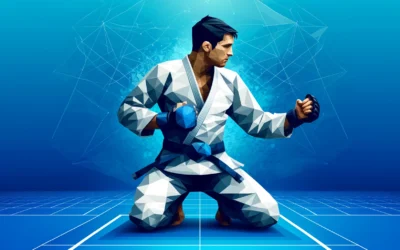Don Bradman is widely regarded as the greatest cricketer of all time. His Test batting average of 99.94 has never been matched, let alone surpassed. So, what can martial artists learn from Bradman’s extraordinary batting prowess? As it turns out, quite a lot.
Bradman achieved his supreme ability through years of dedicated training. His unorthodox batting technique, intense practice methods, and mastery of timing offer valuable lessons for martial artists seeking to hone their skills. In this article, we’ll examine Bradman’s unique approach to batting and training and discuss critical principles martial artists can apply in their practice.
Bradman’s Unorthodox Technique
Don Bradman used an unconventional “rotary” batting technique, unlike most cricketers. Instead of moving the bat straight back and through, he kept its face closed and levered it in a continuous circular arc. This enabled him to get the bat in the correct position faster while maintaining superb balance.
Bradman perfected this technique as a child, practising with a cricket stump and golf ball. He continued using it throughout his career, even though it contradicted accepted coaching wisdom. His unorthodox style allowed him to adapt better and find personalized solutions.
This highlights the value of developing techniques tailored to your strengths for martial artists. While you need solid foundations, don’t just copy others. Experiment to find motions and stances that maximize your power, balance and efficiency. Refine these over time until they become natural.
The Importance of Timing
Bradman’s unique technique gave him a key advantage – superior timing. By minimizing extraneous movements, he could wait longer before committing to his stroke. This allowed him to track the ball’s trajectory and make fine adjustments until the last moment.
Bradman prioritized timing over textbook technique. He knew the key was getting the bat to the right place at the right time, not conforming to the prescribed form. His adaptive style lets him vary his technique slightly to play different types of deliveries.
Timing is critical in martial arts, too. Power and technique are essential, but timing enables you to execute moves decisively and efficiently. Just as Bradman practised his timing for years, devote time to honing yours through drills, repetitions and sparring. Develop an innate sense of rhythm, distancing and motion.
Bradman’s Nonlinear Approach
Don Bradman’s mastery was rooted in constant refinement through a nonlinear training methodology. Rather than rigidly adhering to fixed techniques, he continuously experimented and evolved his style over thousands of repetitions.
This aligns with the principles of nonlinear pedagogy – an approach focused on adaptability, variability and individualized learning solutions. Key aspects include:
Manipulating Constraints – Bradman emphasized deliberately influencing various conditions and settings in practice to force adaptation. For example, he would practice with different-weight bats, balls of varying sizes, and pitches of altered lengths to cause adaptation.
Embracing Variability – Bradman allowed variability in his backlift, grip, and stance during practice to promote adaptability. For example, he would alter his backlift plane, experiment with grips to control edges better and adjust his stance width situationally.
Individualized Solutions – His unorthodox “rotary” technique went against orthodoxy to maximize his strengths. Bradman tailored motions from his grip to backlift arc to enhance his wrist control and balance.
Perception-Movement Coupling – Repetitive basic drills like tapping golf balls ingrained the fluid link between seeing and striking the ball. Bradman also practised seamlessly observing the bowler’s release point to time his stroke.
Discovery Learning – As a child, Bradman learned the basics through play. Experimenting endlessly to hit golf balls better taught him efficient technique. Later, he would field test shots and stances in matches to discover optimal solutions.
The Role of Focused Practice
While natural talent played a part, Bradman’s prowess mainly came from intense, deliberate practice. He endlessly repeated basic drills to program his technique and timing into muscle memory. In matches, he analyzed his every stroke afterwards to improve.
Some critical aspects of his focused practice include:
Simplicity
Bradman honed his skills as a child by hitting golf balls with a stump. This basic drill ingrained the fundamentals. Martial artists should also devote time to basic techniques – striking pads, kicking bags, repeating forms. These repetitive drills build critical foundations.
Intensity
Even as a national star, Bradman continued rigorous training like a beginner. He replicated match conditions and played full-intensity innings in the nets. To improve, martial artists must train beyond comfort through high-volume, high-intensity practice.
Concentration
Bradman emphasized unwavering concentration to stay focused over long sessions. This developed his mental stamina for matches. Likewise, martial artists need concentrated effort in solo drills and sparring. Never switch off or go through motions without full attention.
Analysis
After every inning, Bradman dissected his performance and adjusted his technique based on the results. Martial artists should analyze their training honestly, assess weaknesses and tailor the practice to target those areas.
Experimentation
Bradman continuously experimented with minor modifications to keep improving. He field-tested new shots and stances in matches. Martial artists should also refine techniques through ongoing experimentation to find personalized enhancements.
Deliberate Difficulty
To build skills under pressure, Bradman deliberately made the practice more challenging, like leaving bowling machines on the highest settings. Martial artists can use overload training, resistance tools and padded partners to force improvement under stressful conditions.
By embracing these practice principles, Bradman made incremental gains over thousands of hours, compounding into legendary ability. Martial artists require the same dedicated, intentional training to reach their full potential.
Martial Arts Lessons From The Don
Don Bradman provides an excellent model for mastery through his passionate devotion to training, unorthodox technique and surgical batting skill. By studying his methods, martial artists can glean these key lessons:
- Find personalized techniques that maximize your strengths.
- Refine timing above all else – get the basics right before adding power or speed.
- Practice core skills relentlessly with total concentration.
- Analyze and experiment continually to make incremental improvements.
- Build skills under simulated pressure.
- Tailor training to address your weaknesses.
- Minimize preparatory motions and delay commitment as long as possible.
- Master footwork and balance to handle unpredictability.
While natural ability offers a head start, sustained, dedicated training is essential to achieve expertise. If martial artists adopt Bradman’s principles, they can also turn raw potential into world-class performance. With enough quality practice, the heights attained by legends like Bradman are attainable by all determined learners.





0 Comments